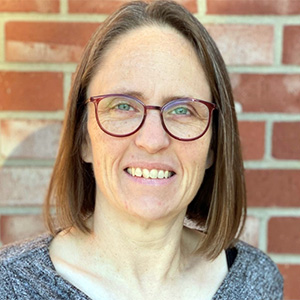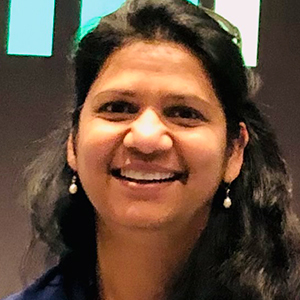Biomolecular visualization tools cross paths, join hands at an ASBMB meeting
Bonnie Hall and Swati Agrawal, both faculty at teaching-focused institutions, recognize the challenges students face when presented with visually complex biomolecules. Both have looked for active-learning approaches to enhance student learning in this context.
One approach is having students explore printed three-dimensional models of biomolecules, such as proteins or DNA, which can provide a much better sense of the molecules’ structure than two-dimensional pictures in a textbook, thus helping them understand those molecules’ functions.
This can be taken one step further using biomolecular modeling, where students design the models themselves. Another approach is using virtual models, especially with tools such as virtual or augmented reality, that allow them to interact with virtual versions of biomolecules.
Bonnie Hall: We use biomolecular modeling to build community
At the 2018 American Society for Biochemistry and Molecular Biology annual meeting, Judy Levine’s students from Goucher College presented a poster accompanied by a 3D-printed model of a protein. The students were so enthusiastic about the literature they had read and the models they had designed to highlight key protein functions. I wanted to learn more about doing this on my own campus.
Margaret Franzen was leading the Connecting Researchers, Educators and Students program, known as CREST, and the printed models I saw at the conference were a part of that program. Margaret explained the program details to me and invited our campus to participate. Given the enthusiasm levels of the students presenting at the conference, I decided to give it a try at Grand View University.
Grand View is a teaching-focused institution, so I made the project part of a new undergraduate course called “Biomolecular Modeling.” I wasn't sure how this course would work, so I opted to co-teach it with a departmental colleague, Laura Salazar.
We had both been reading a lot about the need for inclusivity in science, technology, engineering and mathematics — and about how a more inclusive environment could improve persistence, especially among students from groups that are underrepresented in STEM. We decided to invite first- and second-year students as well as transfer students new to our campus to participate. We hoped a course that showed how science worked outside a textbook and that included students at a range of levels would help build connections between the students and so help retain them in STEM.
The CREST program provided a general topic area each year, and our first year focused on work by Christine Dunham, a professor of chemistry at Emory University who had been chosen to receive the 2019 ASBMB Young Investigator Award. Our six students began reading articles from the Dunham lab, as we needed to identify our specific topic quickly. We decided to focus on the regulation of translation by the killer protein HigB.
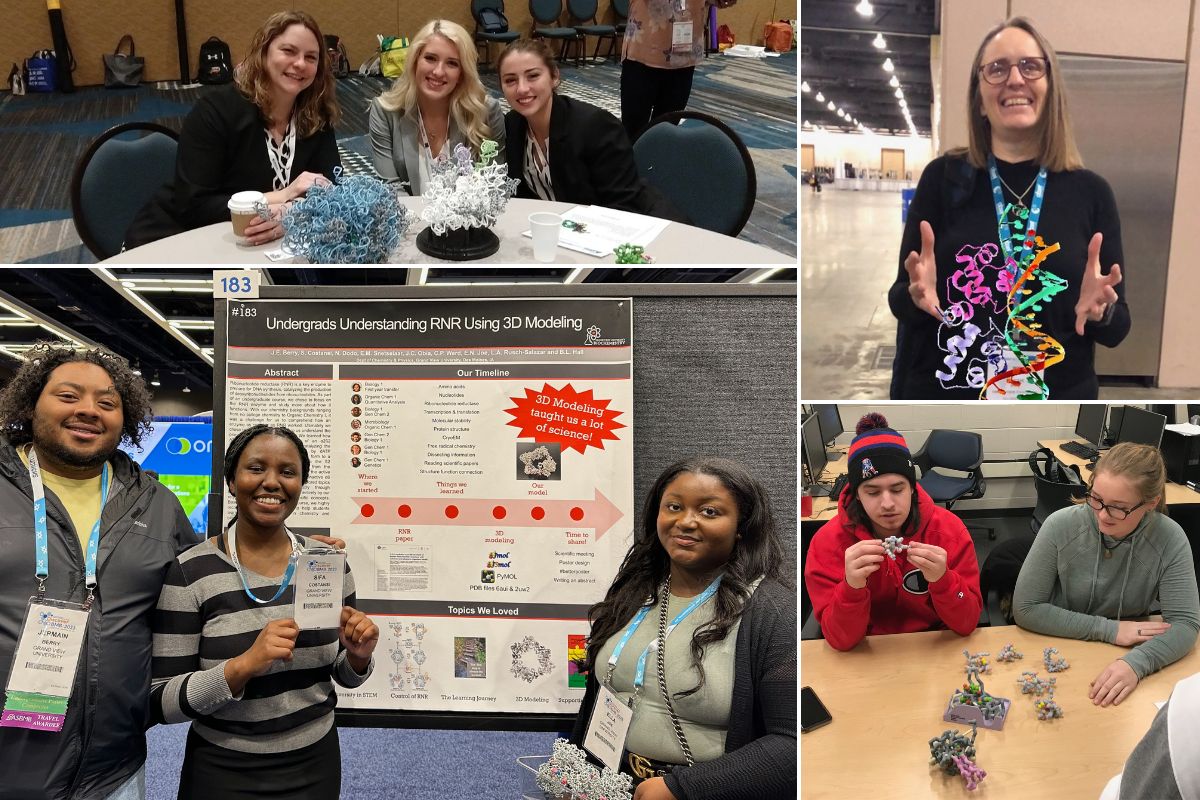
The students built a model of the HigB protein using Jmol and then printed it with a plaster-like material. They presented their model and poster at a CREST event at the 2020 ASBMB annual meeting. Kameron Wheelock was one of the students who attended the meeting.
“I believe taking this course and developing a sense of community early in my career helped me succeed,” she said.
Kameron spent the past two years as a clinical trial coordinator and will start anesthesiology school this spring.
We continued to offer the course, primarily focusing on the work of ASBMB award winners such as Celia Schiffer, Tobias Walther and Robert Farese, because we knew they’d have a strong publication record and well-developed research questions. In the first few weeks of the course, students learned how to gain access to scientific articles and how to read abstracts, so they could select an article to focus on.
To dive deeply into the chosen topic, we often assigned a paragraph or two of the article for outside reading. During class, students would ask questions or request clarification to help them understand what they had read; this often led to mini-lectures. For example, students who were taking general chemistry or introductory biology would realize they didn’t know enough about the classic biochemistry topic of amino acids and protein structure/folding to understand the article, so they demanded more advanced content.
These students were asking to learn challenging topics without an exam driving them — for me, as an educator, this was exhilarating.
During the pandemic, one team modeled nsp5, reported in 2020 by Zhengming Yin and colleagues as the main protease of SARS-CoV2, and then used a lead compound to do a mini–drug-design project. Dalton Dencklau, a member of that team, presented their modeling work at the 2021 ASBMB annual meeting and was also invited to give a poster at the PDB50, a virtual symposium marking the 50th anniversary of the Protein Data Bank.
“If I did not have this class,” Dencklau said, “I am not sure If I would’ve been exposed to, or had the confidence to pursue, external research opportunities.” He is now interviewing with graduate programs for a fall 2024 start in a doctoral program.
National Science Foundation funding for the undergraduate CREST program ended in 2021, but the impact on our students, especially the community building for underrepresented students in STEM, was so strong that we decided to continue.
With no prior exposure to general chemistry or biology courses, Jermain Berry connected to other students in the biomolecular modeling class and said he began to feel like he “belonged in a science program.” He was on a team that built a model of ribonucleotide reductase based on work from the lab of Catherine Drennan, the 2023 recipient of the ASBMB William C. Rose award.
With an ASBMB Student Chapter Travel Award, Berry was able to participate in the undergraduate poster competition at Discover BMB 2023 in Seattle. He has stayed in STEM and is currently completing upper-division courses as a biochemistry major.
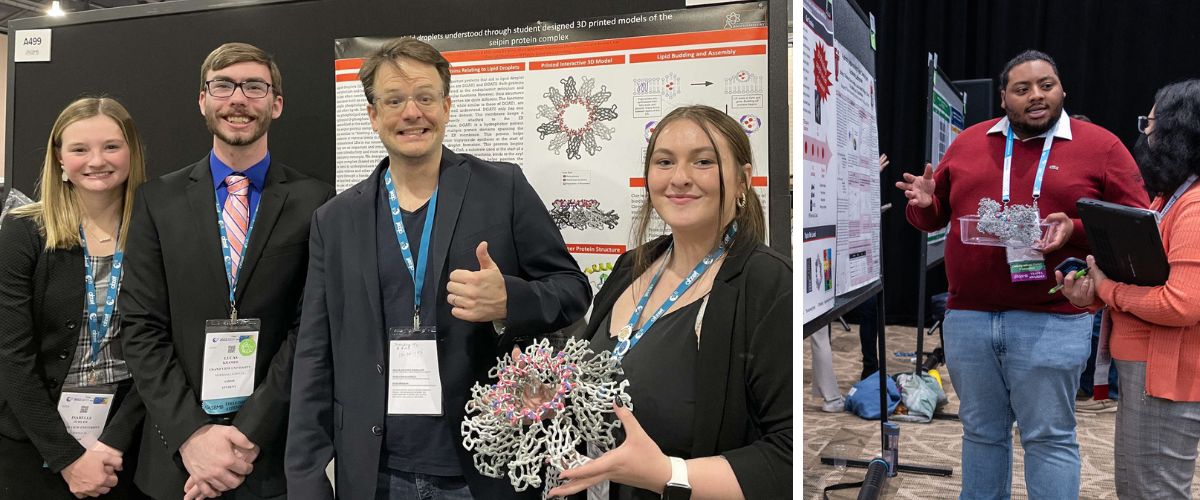
Swati Agrawal: We experience biomolecules through augmented reality
Back when I was a visiting assistant professor at Washington College in 2018, I carried a basket of pipe cleaners, Legos, Play-Doh and Twizzlers to my cell biology class to help my students understand the 3D complexities of biomolecules. Two-dimensional textbook images were insufficient for them to grasp these complex structures, but my simple tools did not fully bridge the gap. The props, while effective in certain aspects, couldn't fully capture the intricacies of structure and function that I aimed to convey.
Visual literacy in this context is an iterative process of skill building. It begins with the student’s ability to internalize visual models, progresses to conceptualizing these models, and culminates in externalizing or expressing information in the form of visual models. Exposing students to the 3D intricacies of biomolecules through diverse tools and mediums in the classroom can help them better understand structure-function relationships.
I envisioned a more interactive and immersive approach. At that time, virtual reality tools for biomolecular visualization came with a substantial price tag and bulky equipment — both impractical for my classroom. I collaborated with the education technologist to develop a visualization tool with which any Protein Data Bank structure image can be transformed into an augmented reality, or AR, object using the Merge Cube platform. With a handheld foam cube, students gained access to accurate representations and were able to seamlessly rotate and zoom in and out of biomolecular structures.
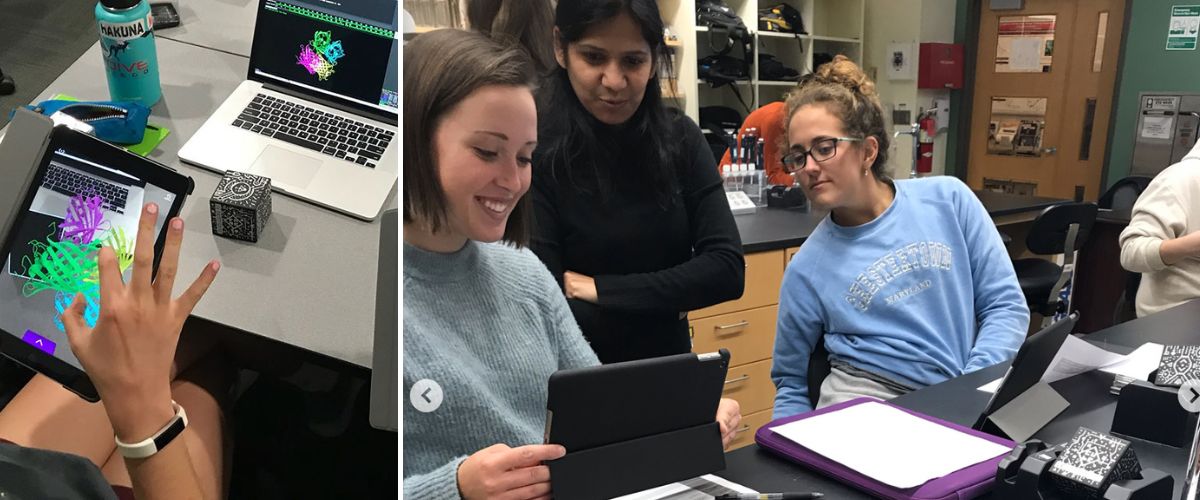
This approach not only offered a more engaging learning experience but also converted abstract biomolecules into tangible models. For example, nucleotide–protein interactions are often difficult for students to visualize, which makes gene expression a challenging concept. An AR rendition of DNA comparing the unbound state with the transcription factor–bound state helps students see and understand the concept of differential gene expression. Gabrielle Moore, a student in my cell biology class, said, "I had always read about DNA's major and minor grooves, but being able to visualize them up close was truly fascinating."
Educators and focus groups also received the tool enthusiastically during workshops at the Association for Biology Laboratory Education Conference in 2019, the 2021 ASBMB annual meeting, BioMolviz and the Molecular CaseNet. One workshop participant at the ABLE conference commented, "Visualizing protein structure in AR makes the class teaching a game play experience."
A comprehensive guide to using this tool in the classroom, accompanied by readily deployable classroom activities, was published recently in the Biochemistry and Molecular Biology Education Journal.
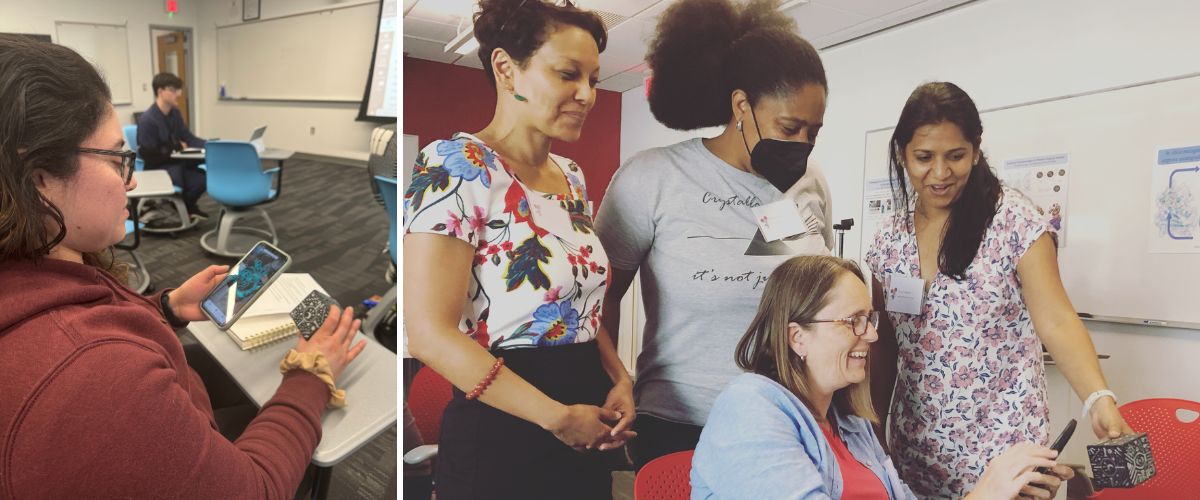
A case study in collaboration
Lucas Kramer and Isabelle Juhler were part of a Grand View team that built and presented a seipin model at the 2022 ASBMB annual meeting in Philadelphia. During a poster session, the seipin modeling team flocked to a poster showcasing the AR tool that used Merge Cube to create protein structures.
“Seeing the AR tool at ASBMB 2022 was a unique experience,” Kramer said. “I hope future biochemistry classes can utilize it when learning about protein structure because it was an exciting experience seeing proteins in a new perspective.”
A shared enthusiasm for biochemistry education using tools such as 3D printed models and AR models catalyzed a student-led collaboration between our students at the University of Mary Washington and Grand View. Juhler is developing two case studies using the seipin structure and lipid droplet biology to enhance student understanding of both lipid and protein structure and function. The case studies will employ a variety of instructional tools, including AR, printed models and online visualization tools, providing a multifaceted approach to enhance engagement and improve students' comprehension of structure-function relationships of complex biomolecules. She has submitted an abstract to present a poster at Discover BMB 2024 in San Antonio.
“The development of these case studies has allowed me to take my previous work with seipin in a new and exciting direction,” Juhler said. “These tools are what inspired me to continue with this project, and I am eager for other undergraduate students to use them as a part of their coursework. I credit much of my success to participating in biomolecular modeling early on in my undergraduate career.”
Do it yourself
Would you like to use biomolecular modeling or AR structures on your campus?
You can see previous CREST projects online. You can also print models or check out the article on how to make AR versions of the protein you’re interested in.
We hope to see you at Discover BMB in San Antonio in March, and we’re happy to answer any questions.
Enjoy reading ASBMB Today?
Become a member to receive the print edition four times a year and the digital edition monthly.
Learn moreGet the latest from ASBMB Today
Enter your email address, and we’ll send you a weekly email with recent articles, interviews and more.
Latest in Education
Education highlights or most popular articles

Summer research spotlight
The 2025 Undergraduate Research Award recipients share results and insights from their lab experiences.

Debugging my code and teaching with ChatGPT
AI tools like ChatGPT have changed the way an assistant professor teaches and does research. But, he asserts that real growth still comes from struggle, and educators must help students use AI wisely — as scaffolds, not shortcuts.

How AlphaFold transformed my classroom into a research lab
A high school science teacher reflects on how AI-integrated technologies help her students ponder realistic research questions with hands-on learning.

Writing with AI turns chaos into clarity
Associate professor shares how generative AI, used as a creative whiteboard, helps scientists refine ideas, structure complexity and sharpen clarity — transforming the messy process of discovery into compelling science writing.
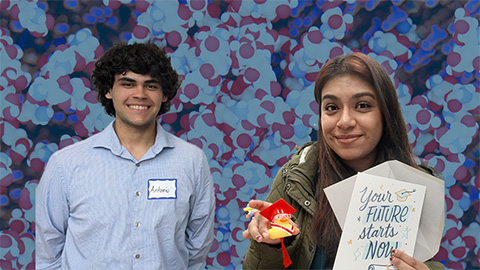
How undergrad research catalyzes scientific careers
Undergraduate research doesn’t just teach lab skills, it transforms scientists. For Antonio Rivera and Julissa Cruz–Bautista, joining a lab became a turning point, fostering critical thinking, persistence and research identity.

Talk nerdy to me: Communicating research that matters
Master science communication: learn to engage the public, work with the press and explore new careers — from consulting to media — through ASBMB’s Art of Science Communication course.

